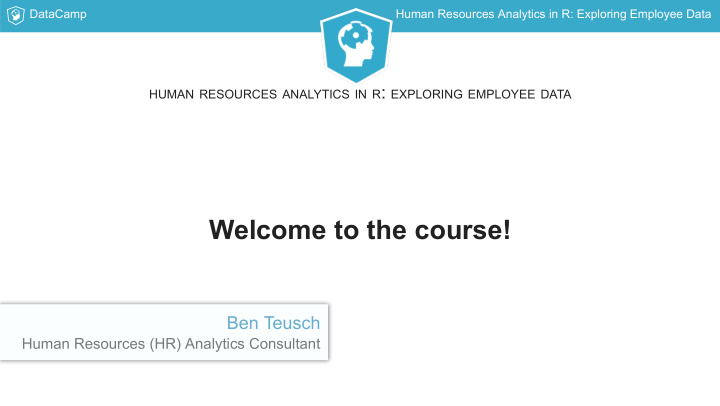



DataCamp Human Resources Analytics in R: Exploring Employee Data HUMAN RESOURCES ANALYTICS IN R : EXPLORING EMPLOYEE DATA Welcome to the course! Ben Teusch Human Resources (HR) Analytics Consultant
DataCamp Human Resources Analytics in R: Exploring Employee Data Introduction to HR analytics also known as people analytics, workforce analytics, or talent analytics a data-driven approach to managing people at work
DataCamp Human Resources Analytics in R: Exploring Employee Data Tools for the course
DataCamp Human Resources Analytics in R: Exploring Employee Data A general process for HR analytics Identify the groups to compare Calculate summary statistics about those groups Plot or test the differences between those groups
DataCamp Human Resources Analytics in R: Exploring Employee Data Identify the groups to compare
DataCamp Human Resources Analytics in R: Exploring Employee Data Calculate summary statistics about each group > mean(finance$tenure) [1] 4.81287 > mean(engineering$tenure) [1] 5.78693 > max(engineering$overtime_hours_worked) [1] 188 > sum(finance$sick_days) [1] 372
DataCamp Human Resources Analytics in R: Exploring Employee Data Compare the differences statistically or visually
DataCamp Human Resources Analytics in R: Exploring Employee Data Course Overview Chapter 1: Identifying the best recruiting source Chapter 2: What is driving low employee engagement? Chapter 3: Are new hires getting paid too much? Chapter 4: Are performance ratings being given consistently? Chapter 5: Improving employee safety with data
DataCamp Human Resources Analytics in R: Exploring Employee Data HUMAN RESOURCES ANALYTICS IN R : EXPLORING EMPLOYEE DATA Let's practice!
DataCamp Human Resources Analytics in R: Exploring Employee Data HUMAN RESOURCES ANALYTICS IN R : EXPLORING EMPLOYEE DATA Applying the HR analytics process Ben Teusch HR Analytics Consultant
DataCamp Human Resources Analytics in R: Exploring Employee Data Applying the process to recruiting
DataCamp Human Resources Analytics in R: Exploring Employee Data Applying the process to recruiting
DataCamp Human Resources Analytics in R: Exploring Employee Data Quality of hire What makes one hire better than another? retention, or how long the employee stays their manager's satisfaction with the hire job performance the amount of time it takes to become fully productive > names(recruitment) [1] "attrition" "performance_rating" "sales_quota_pct" [4] "recruiting_source"
DataCamp Human Resources Analytics in R: Exploring Employee Data Calculating the attrition rate attrition rate: attrition headcount If attrition = 1 when the employee left, this can be rewritten as: mean ( attrition )
DataCamp Human Resources Analytics in R: Exploring Employee Data Review of tools from dplyr > library(dplyr) > > recruitment %>% + group_by(recruiting_source) %>% + summarize(highest_performance = max(performance_rating)) %>% + arrange(highest_performance) # A tibble: 4 x 2 recruiting_source highest_performance <chr> <dbl> 1 Search Firm 3 2 Referral 4 3 Applied Online 5 4 Campus 5
DataCamp Human Resources Analytics in R: Exploring Employee Data New Tools > recruitment %>% + count(recruiting_source) # A tibble: 4 x 2 recruiting_source n <chr> <int> 1 Applied Online 130 2 Campus 56 3 Referral 45 4 Search Firm 10
DataCamp Human Resources Analytics in R: Exploring Employee Data HUMAN RESOURCES ANALYTICS IN R : EXPLORING EMPLOYEE DATA Let's practice!
DataCamp Human Resources Analytics in R: Exploring Employee Data HUMAN RESOURCES ANALYTICS IN R : EXPLORING EMPLOYEE DATA Visualizing recruiting data Ben Teusch HR Analytics Consultant
DataCamp Human Resources Analytics in R: Exploring Employee Data Small number of groups > call_center_a %>% + group_by(team) %>% + summarize(avg_calls = mean(calls_made)) %>% + arrange(desc(avg_calls)) team avg_calls <chr> <dbl> 1 D 84.21283 2 B 79.65947 3 A 73.80612 4 C 61.73712
DataCamp Human Resources Analytics in R: Exploring Employee Data Large number of groups > call_center_b %>% + group_by(team) %>% + summarize(avg_calls = mean(calls_made)) %>% + arrange(desc(avg_calls)) team avg_calls <fctr> <dbl> 1 J 98.16318 2 U 89.64824 3 M 84.90123 4 L 82.90802 5 D 82.62958 6 E 82.08344 7 C 80.46505 8 K 79.91899 9 F 77.28148 10 R 75.66100 # ... with 16 more rows
DataCamp Human Resources Analytics in R: Exploring Employee Data A simple bar chart > call_center_b_summary team avg_calls <fctr> <dbl> 1 J 98.16318 2 U 89.64824 3 M 84.90123 4 L 82.90802 5 D 82.62958 6 E 82.08344 7 C 80.46505 8 K 79.91899 9 F 77.28148 10 R 75.66100 # ... with 16 more rows > ggplot(call_center_b_summary, aes(x = team, y = avg_calls)) + + geom_col()
DataCamp Human Resources Analytics in R: Exploring Employee Data A simple bar chart
DataCamp Human Resources Analytics in R: Exploring Employee Data A polished bar chart
DataCamp Human Resources Analytics in R: Exploring Employee Data HUMAN RESOURCES ANALYTICS IN R : EXPLORING EMPLOYEE DATA Let's practice!
Recommend
More recommend